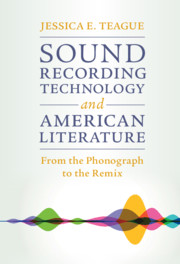Book contents
- Sound Recording Technology and American Literature
- Cambridge studies in American Literature and Culture
- Sound Recording Technology and American Literature
- Copyright page
- Dedication
- Contents
- Figures
- Acknowledgments
- Introduction Resonant Reading
- Chapter 1 Ears Taut to Hear
- Chapter 2 Ethnographic Transcription and the Jazz Auto/Biography
- Chapter 3 Press Play
- Chapter 4 The Stereophonic Poetics ofLangston Hughes and Amiri Baraka
- Chapter 5 From Cut-up to Mashup
- A Post-Electric Postscript Recording and Remix Onstage
- Notes
- Works Cited
- Index
- Recent Books In This Series (continued from page ii)
Chapter 4 - The Stereophonic Poetics ofLangston Hughes and Amiri Baraka
Published online by Cambridge University Press: 07 May 2021
- Sound Recording Technology and American Literature
- Cambridge studies in American Literature and Culture
- Sound Recording Technology and American Literature
- Copyright page
- Dedication
- Contents
- Figures
- Acknowledgments
- Introduction Resonant Reading
- Chapter 1 Ears Taut to Hear
- Chapter 2 Ethnographic Transcription and the Jazz Auto/Biography
- Chapter 3 Press Play
- Chapter 4 The Stereophonic Poetics ofLangston Hughes and Amiri Baraka
- Chapter 5 From Cut-up to Mashup
- A Post-Electric Postscript Recording and Remix Onstage
- Notes
- Works Cited
- Index
- Recent Books In This Series (continued from page ii)
Summary
In Chapter 4, I consider how poets reconfigured the long-play stereo album and challenged the spatial limits of the printed book. In particular, I turn to Langston Hughes’s LP book Ask Your Mama: 12 Moods for Jazz (1961) and Amiri Baraka’s poetry album It’s Nation Time (1972), recorded for Motown’s Black Forum label, in order to discuss how the stereo LP opened new black sonic spaces at a contentious moment in history. While many poets made recordings during the 1960s, what distinguishes these works is their ongoing dialogue with the specificities of stereo sound, the LP, and sound in its spatial dimensions. Part of what is radical about a stereophonic poetic is the way that it opens a space within a space -- one that sits neither inside nor outside history.
- Type
- Chapter
- Information
- Sound Recording Technology and American LiteratureFrom the Phonograph to the Remix, pp. 128 - 163Publisher: Cambridge University PressPrint publication year: 2021

